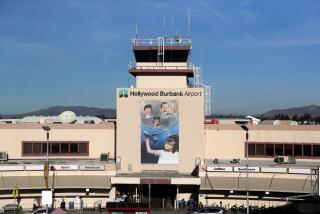Spirit of Cooperation Would Let Burbank Airport Plan Fly
- Share via
Travelers in and out of Burbank Airport know how convenient--and frustrating--the cramped, aging terminal can be. But plans to build a larger, more modern terminal building have for years been grounded by bickering among the three cities that control the airport: Burbank, Glendale and Pasadena. In an effort to break the costly stalemate, Burbank officials last week proposed a compromise plan to get the project started.
Burbank’s proposal deserves the careful consideration of the full Burbank-Glendale-Pasadena Airport Authority, the independent agency that manages the airport on behalf of the cities. Dubbed the “Burbank Airport 21st Century Plan,” Burbank’s proposal offers the best hope to date of resolving the dozen lawsuits that encumber the project and of restoring civility and trust to the three cities’ official relationships. Sadly, however, it may change nothing in the childish spitting match that has marked the airport’s recent past.
Current plans call for the construction of a new terminal with 19 gates on land owned by the Lockheed Martin Corp. just north of the existing facility. Burbank’s proposal instead suggests 16 gates--two more than the current building--with caps on the annual number of flights and a curfew to restrict nighttime activity. Burbank also wants assurances that noise from the airport will not increase. While it sounds reasonable and achievable, the Burbank plan is fraught with many of the same conditions and demands at the heart of the current standoff.
Airport officials continue to insist that the restrictions Burbank wants are virtually impossible to enforce, saying that the facility is already among the quietest of its size in the country. Burbank officials disagree, arguing that the Federal Aviation Administration would probably sign off on the rules if the three cities and the airlines presented a united front. That’s just a hint of how polarized the viewpoints are. For instance, Burbank and the airport authority can’t even agree on whether mediation talks on the expansion continue.
Burbank’s plan may not be perfect, but it opens the door to more productive discussions, if nothing else. It is an incremental step toward resolution. Burbank officials are charged with protecting the interests and desires of their constituents, those most directly affected by any expansion. Likewise, the other cities need to maximize their return on investment in the airport. If both sides are serious about finding a solution, they must sit down to negotiate honestly and openly--forgetting the nasty baggage of the past. The other cities need to listen--really listen--to Burbank’s concerns over noise and traffic. Burbank, in turn, needs to realize that the FAA may reject its proposed caps and curfews. Then what? Dropping back into an adversarial role is not the answer because if history is any guide, the city’s legal fights will end up costing more than they return.
The problems facing Burbank Airport are not intractable. Solving them, though, requires negotiations that are at once compassionate and realistic. Burbank, Glendale and Pasadena all want the same thing: A new terminal that benefits everyone. They’re partners, not enemies. They should start acting like it.
More to Read
Sign up for Essential California
The most important California stories and recommendations in your inbox every morning.
You may occasionally receive promotional content from the Los Angeles Times.










